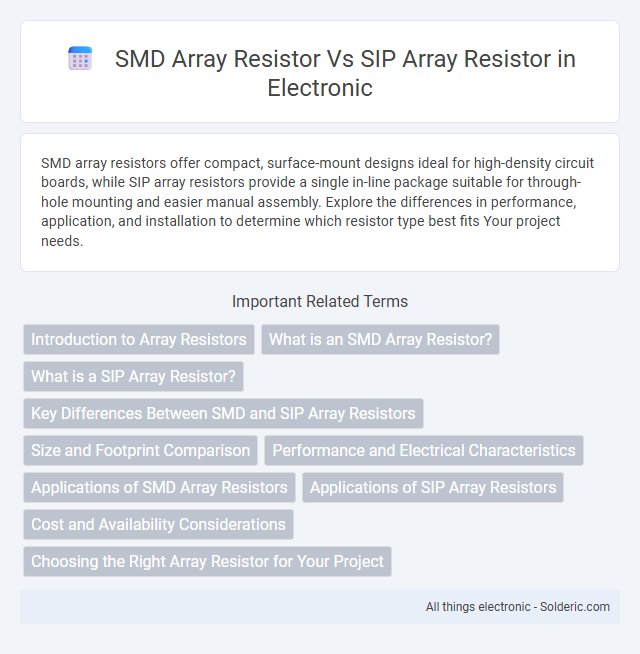SMD array resistors offer compact, surface-mount designs ideal for high-density circuit boards, while SIP array resistors provide a single in-line package suitable for through-hole mounting and easier manual assembly. Explore the differences in performance, application, and installation to determine which resistor type best fits Your project needs.
Comparison Table
| Aspect | SMD Array Resistor | SIP Array Resistor |
|---|---|---|
| Package Type | Surface-Mount Device (SMD) | Single In-line Package (SIP) |
| Mounting Method | Surface Mount Technology (SMT) | Through-Hole Mounting |
| Size | Compact, low profile | Larger, taller footprint |
| Integration Density | High, suitable for dense PCB layouts | Lower, less suitable for compact designs |
| Power Rating | Typically 0.1W to 0.25W per resistor | Higher power, up to 0.5W or more |
| Applications | Modern electronics, compact devices | Prototyping, legacy systems, higher power needs |
| Thermal Performance | Lower heat dissipation capability | Better heat dissipation due to leads |
| Cost | Generally lower in high volume SMT assembly | Higher manual soldering cost |
| Reliability | Good for vibration-resistant environments | Robust mechanical connections |
Introduction to Array Resistors
Array resistors, including SMD (Surface-Mount Device) and SIP (Single In-line Package) types, serve to integrate multiple resistor elements into a compact package, reducing PCB space and simplifying circuit design. SMD array resistors offer a low-profile, surface-mounted solution with precise resistance values ideal for high-density, automated assembly environments, while SIP array resistors provide through-hole mounting suitable for prototyping or applications requiring robust mechanical connections. Choosing the right array resistor depends on your design requirements, including space constraints, assembly method, and electrical specifications.
What is an SMD Array Resistor?
An SMD array resistor is a compact, surface-mounted component that integrates multiple resistors into a single package, optimizing space on printed circuit boards (PCBs). This design reduces assembly time and improves circuit reliability by minimizing the number of discrete components needed. Your PCB design benefits from enhanced efficiency and simplified routing when using SMD array resistors compared to SIP array resistors, which are single in-line packages with resistors connected in a row through through-hole mounting.
What is a SIP Array Resistor?
A SIP (Single In-line Package) array resistor consists of multiple resistors housed in a single, compact package with one row of connecting pins, designed for easy PCB insertion and soldering. It provides a high-density resistor solution ideal for space-saving applications requiring consistent resistance values across multiple circuits. Compared to SMD (Surface-Mount Device) array resistors, SIP arrays offer simpler manual assembly but typically occupy more board space and have lower resistance tolerance options.
Key Differences Between SMD and SIP Array Resistors
SMD array resistors are surface-mount devices designed for compact PCB layouts, offering high density and automated assembly compatibility, whereas SIP array resistors are single in-line package components suited for through-hole mounting and prototyping. SMD arrays provide better performance in high-frequency circuits due to lower lead inductance, while SIP arrays allow easier manual replacement and testing. The choice depends on PCB design constraints, assembly methods, and application-specific electrical requirements.
Size and Footprint Comparison
SMD array resistors feature a significantly smaller size and footprint compared to SIP array resistors, making them ideal for compact electronic designs and high-density PCB layouts. SIP array resistors have a larger, linear footprint that occupies more board space, often used in applications where size constraints are less critical. Choosing an SMD array resistor helps optimize Your circuit's space efficiency and supports advanced miniaturization requirements.
Performance and Electrical Characteristics
SMD array resistors offer superior high-frequency performance and lower parasitic inductance compared to SIP array resistors, making them ideal for compact, high-speed circuits. SIP array resistors typically have higher power ratings and easier heat dissipation due to their larger package size but exhibit increased lead inductance and noise. Your choice between SMD and SIP array resistors should consider the trade-offs between signal integrity and power handling based on the specific electrical characteristics required for your application.
Applications of SMD Array Resistors
SMD array resistors are widely used in compact electronic devices such as smartphones, laptops, and wearable technology due to their small size and ease of automated assembly. They are ideal for high-density printed circuit boards (PCBs) requiring precise current control and signal integrity in applications like voltage dividers, pull-up/pull-down networks, and LED drivers. Their surface-mount design allows for efficient heat dissipation and improved reliability in harsh environments, making them suitable for automotive and industrial electronics.
Applications of SIP Array Resistors
SIP array resistors are widely used in applications requiring high-density resistor configurations, such as in telecommunications equipment, digital circuits, and signal processing systems. They offer compact integration in circuit boards where space constraints exist but individual resistor tuning or discrete connections are necessary. SIP array resistors provide reliable performance in current limiting, pull-up/pull-down resistor networks, and voltage dividing applications within industrial control systems and microcontroller interfacing.
Cost and Availability Considerations
SMD array resistors generally offer lower cost and higher availability due to widespread use in automated surface-mount technology manufacturing. SIP array resistors can be more expensive and harder to source as they are typically used in niche or legacy applications. Your choice depends on the production scale and component sourcing constraints, with SMD arrays often favored for economical, high-volume projects.
Choosing the Right Array Resistor for Your Project
Choosing the right array resistor depends on your project's size constraints, power dissipation needs, and assembly method. SMD array resistors offer compactness and suitability for automated surface-mount technology, making them ideal for high-density circuit boards with limited space. SIP array resistors provide easier manual installation and higher power ratings, suitable for prototyping or applications requiring straightforward through-hole mounting.
SMD array resistor vs SIP array resistor Infographic

 solderic.com
solderic.com